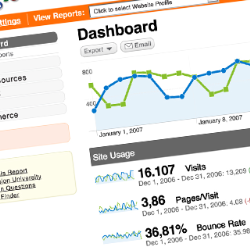We can’t all be data dynamos or number geeks; for some people, a tool such as Google Analytics can be a little overwhelming. Most of you are aware that it provides amazing insights into customer behaviour, but how? Some of you might look at that first page and think “Where do I even start?”
Let me cut through all the fluff and outline which data you should be tracking NOW! All that other mumbo jumbo can wait, these five metrics outlined below will tell you all you need to know about your customers with very little effort. These metrics are so straight forward that anyone can understand them.

Content – Pages
This metric looks at all the pages on your website and ranks them in order of page views, so you can see which pages are popular with your customers and which ones aren’t. Here you will gain valuable insight into what your customers are interested in. You may think your customers are going to your site to view products, but they could be more interested in your blog posts.
From here you can begin tailoring your content to your customers’ interests. If they liked your post ‘6 Business tips you can get from watching Dance Moms’, give them more of that and they’ll keep coming back. Also, you can link your call to action pages such as newsletter subscription to your most popular pages. This will increase the awareness of your newsletter, and hopefully, increase conversions.
Conversions
We all have desired goals when we set up our websites, whether it be for customers to sign up for a newsletter, buy a product or fill out a contact form. When a customer completes a desired action, this is called a conversion. It is important to get new people viewing your site every week, but what is even more important is getting conversions from the visitors you are already getting. There is no point having a million people visit your website if not a single one buys something. That will leave you broke! Therefore, making sure you visitors are turning into conversions is extremely important.
Setting up a “Thanks for your enquiry” page for example, will help you to measure how many people are reaching the initial contact page, and then how many are actually filling out the form and submitting an enquiry. Once you get a baseline for your conversion rate, you can then start to play around and test other layouts, forms and colours to see if they increase your conversion rate.
Visitors
The visitors metric measures exactly what you think it does…visitors, but there are a few little extras you need to take note of. There are two different statistics for visitors; standard visits and unique visitors. Visits are the overall number of visits to your site within a given period, which counts the same person going to your site multiple times as separate visits. Unique visitors takes into account the fact that a person has viewed your site previously and won’t count them again. Each person is counted only once within a given time, giving you a better idea of how many people view your site.
You can also keep track of the percentage of new visitors to your site. Google Analytics estimates the percentage of first time visits. What you want to see here is a high percentage immediately after a new marketing campaign, which means you’ve intrigued a few people and they want to know all about you. Several months later, however, you’ll want to see the new visitors percentage even out with returning visitors, as new visitors become loyal followers.
Traffic Sources
People can reach your website a number of different ways; they can search for it on Google, click a link on that cat meme you created for Facebook or via a referral from another site. The traffic sources metric details exactly how your customers got to your site, and can really help you decide where to focus your time and energy (especially if you don’t have much of either).
You may discover that a lot of your traffic is coming from Twitter, but hang on…you don’t have a Twitter account. This just means that your customers are active on Twitter and are talking about you, A LOT, so it may be worth investing some time creating a Twitter account to really engage them. This metric could also indicate that a small ‘free’ ad you posted in a local directory is getting you some traffic. With this data, you could consider upgrading to a paid ad to see if this drives even more traffic to your website.
Exit Pages
Exit pages outline the exact pages from which visitors leave your site. This metric is extremely important as it gives great insight into the behavior of your customers. If visitors are leaving your website during the checkout process or before completing a signup form, this is bad news and needs to be rectified immediately. It’s possible that people are leaving at the checkout because of the shipping charges, or something as simple as one too many fields to fill out in a signup form.
Even two fields, two buttons, and one link can be too much for consumers to handle. Don’t believe me? Check out this this article “The $300 Million Button” by Jared M. Spool and see how one little button resulted in an extra $300 Million for one company.
What you want see in your exit pages report is visitors leaving your site from order completion pages and form completion thank you pages, so you are 100% sure that your goal has been achieved.
Bounce Rate
This metric measures the percentage of visitors who land on a webpage and then leave your website without viewing any other pages. Bounce rate is calculated by pairing your exit page and landing page statistics.
Interpreting your bounce rate percentage is the tricky part, as it can mean a number of different things. If your bounce rate is high, it could mean that people are entering you site, not finding what they want and leaving, OR it could mean that the one page they viewed was filled with such amazing stuff that you solved all their problems right then and there and they had no reason to look anywhere else. If your bounce rate is low, it can also mean two things; that your site is difficult to navigate so visitors are going from page to page trying to find the information they need, or that they just love your website and want to read every blog post and view every page.
So which one is it? Sadly, the answer is not so simple. To understand the reason behind your bounce rate you will have to use other metrics and statistics. Metrics such as time spent on a page can help you out. If people are viewing only one page, but are spending a lot of time on it, it’s highly likely that they are engaged and reading the content. If they are viewing multiple pages but are only spending five seconds on each one, it’s safe to assume they are merely browsing and are not engaged.
Every business has different objectives, and these will determine which metrics are relevant to you. Hopefully this post has made Google Analytics a little less daunting and helped you understand how to use such a tool to get the most out of your online presence.

